|
In the summer of 2011 I got together with
Bill W4HBK and started testing for the lowest power needed to
communicate a message (my callsign WA5DJJ) between my location
in Las Cruces, New Mexico and his location in Pensacola, Florida.
This time we were going to try a new to us technique of precision
timing of the transmitting call sign using the standard 6 second
dits modulated as QRSS FSKCW and a technique of stacking 10 minute
grabber frames to build a composite picture. What this essentially
does is enhance the signals and de emphasize the noise. It is
a technique that is used by the astronomy buffs to enhance their
star pictures to brighten very dim stars in their CCD captures.
The first test was run at 250 mW power output from my transmitter.
(The transmitter is both crystal oven frequency stabilized and
the keyer uses an exact repeatable software program written by
N0QBH) The following screen shots are the results of our tests.
This test takes some weeks to perform as we also had to wait
on good propagation between the two sites.
|
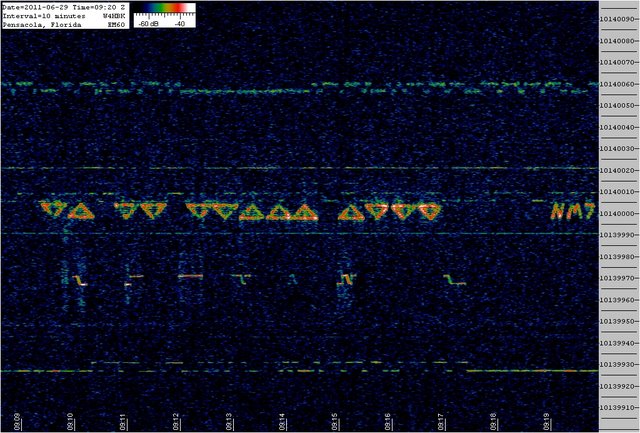
These screen shots were put in here to
show you the difference between the Raw Data and a Stacked Image.
The above screen show is the raw picture
showing my call sign along the bottom of the screen shot at 40mW
power level.
The screen shot below is essentially the
same image but stacked with 4 or more similar 10 second screen
shots to enhance the signal presence. The signals that are transmitted
on an exact 10 minute schedule will be enhanced. The ones that
are not transmitted on that schedule are not. The signal at the
top is P29ZL from Papua, New Guinea who is stabilized. Signal
with the triangles is not 10 minute scheduled and you can see
in the stacked image that the triangles run together and become
unintelligible in the stacked image. The image above mine at
the bottom is Chris WB5FKC who is both stabilized and using a
modulation technique of Differential Frequency Shift Keying (DFSK).
As you can see the weaker signal in the raw data was made very
readable in the "stacked" image.
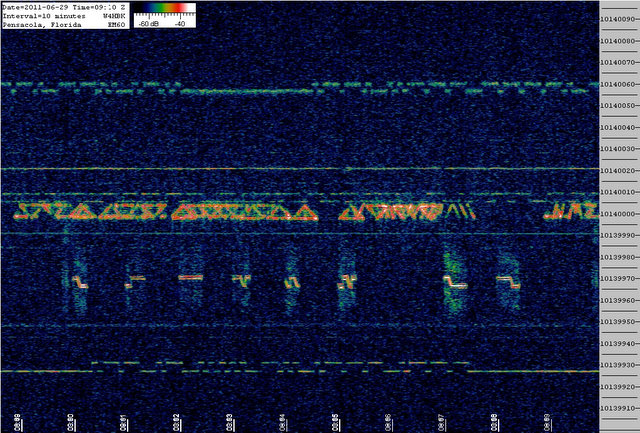 |
100 mW TEST
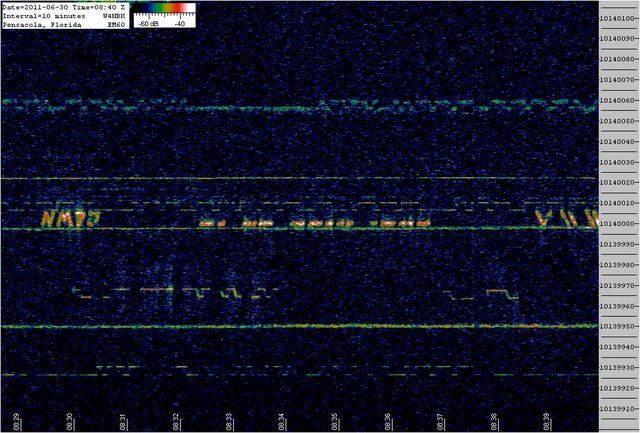
This image was at 100mW and was so clear
that we didn't need to stack the image to prove it was me. The
propagation was better this day than it had been so the 100mW
test went quickly.
|
100uW
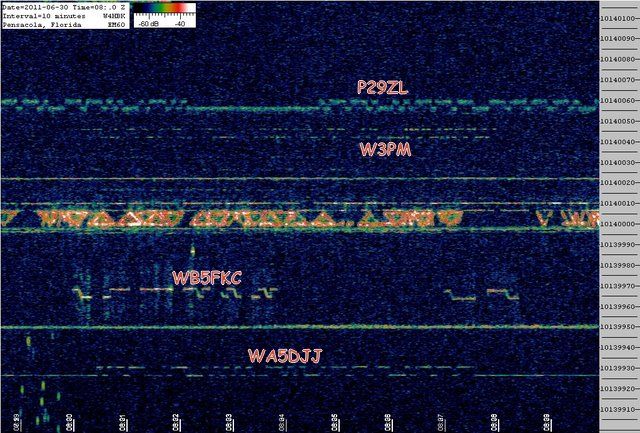
We stepped quickly through the steps between
100mW and 100uW and the pictures were essentially the same for
the stacked images. Here Bill W4HBK annotated the signals in
this "stacked image. My power level in this screen shot
was 100uW (Yes I said 100microwatts or .0001 Watts)
|
48.8uW TEST
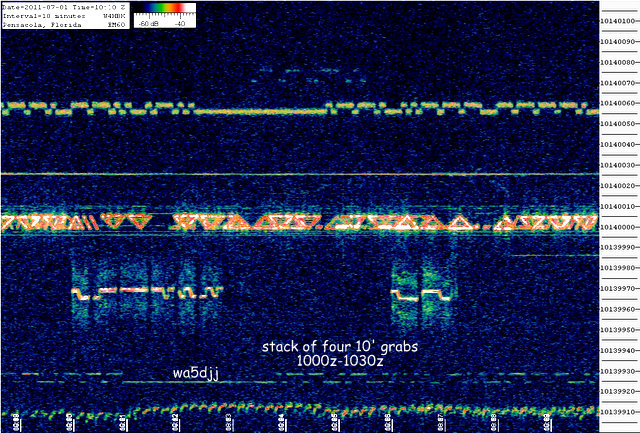
This is the stacked image for 48.8uW. At
this time I had broken my previous record of 65uW for the path
between us that I had accomplished in the 80 second test. As
you can see, The call sign of WA5DJJ is clearly visible in this
screen shot. Now to decrease the power some more... 23.9 uW (The
reason for the odd numbers down here at this range is the difficulty
of making fine adjustments in the transmitter power)
|
23.9uW Test
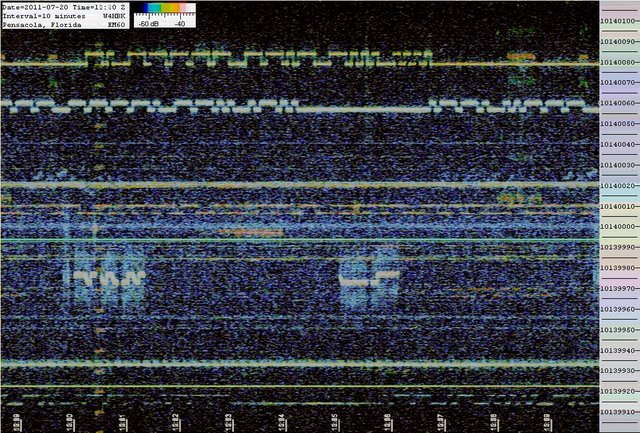
This is the "stacked Image" of
my signal at 23.9 uWatts. We are getting a lot of noise at this
level and the stacked images are not as clean as they were earlier.
But My call sign is still clearly visible along with others on
the page. Some of the dynamic range is also lost as some of the
signals are clearly much stronger than mine and may be distorting
the image. Some change in stacking techniques may be required
to help pull my signals out of the noise. The test is continuing
at a power level of 8.51uW. We are getting down to the ESP Level
now. |
8.51uW TEST
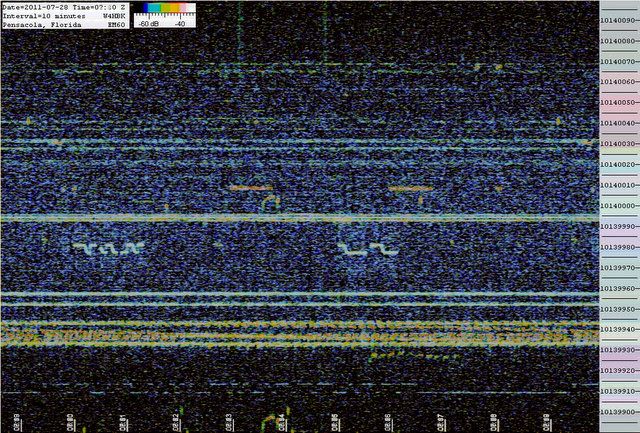
This is the "stacked image" of
my signal at 8.51uWatts. My signal is clearly visible using 12
of the grabbers 10 minute images (that is 2 hours of copy or
120 minutes). W4HBK said that it was visible on the 4 Hour grabber
image for quite some time so the propagation between Las Cruces,
NM and Pensacola, FL must have been very good at these low power
levels. A screen shot of the 4 hour grabber is shown below and
if you look along the 10,139,915 Hz line you will see my signal
is visible for almost 2 hours off and on.
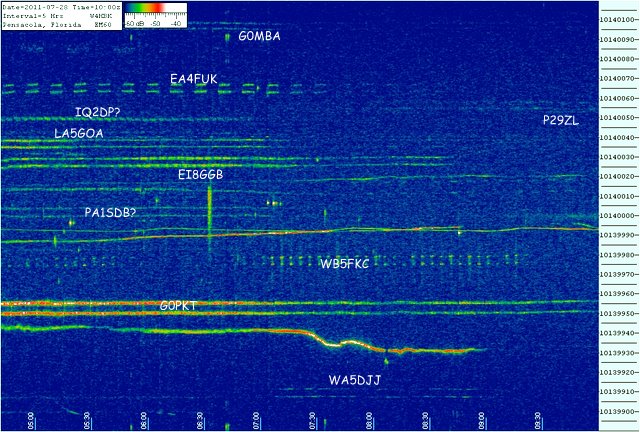
So, The quest continues. The transmitter
is now at 3.89uWatts. We are watching for another bubble in the
30M propagation. Hopefully, we can add another power reading
or two to this website before the little FSKCW signal can no
longer be seen. |
|
back to the QRSS Adventure
page |







